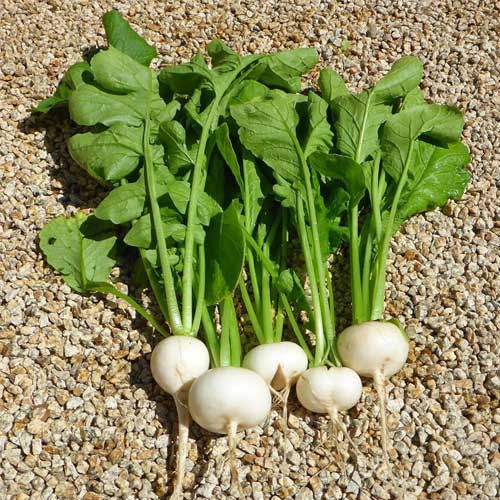Total Number of seeds: 200
Radish White Round Seeds 🌿🥗
Radish White Round Seeds produce small, crisp, white roots that have a sweet and mildly spicy flavor. These radishes are globe-shaped with a smooth surface and tender flesh, making them perfect for fresh salads and garnishing. This variety matures quickly and is easy to grow, making it ideal for home gardens and kitchen gardens. White Round Radish is known for its high yield and uniform roots, providing a consistent harvest.
About This Item 🌿
- Type of Seeds: Open Pollinated, Non-Hybrid Radish Seeds
- Germination Time: 5-7 days
- Hours of Sunlight: Needs 6-8 hours of direct sunlight daily
- Where to Grow: Suitable for gardens, kitchen gardens, or large pots
- Growing Season: Best sown in early spring, late summer, or winter
- Seeds Sowing Depth: 1/2 inch deep
- Ideal Climate: Cool and mild weather
- Plant Height: Grows up to 4-6 inches tall
- Organic Fertilizer Requirement: Use balanced organic fertilizer every 2-3 weeks
- Life Span: Annual plant (grows and produces roots within one season)
- Ideal Growing Temperature: 15-25°C
- Harvesting Time: Ready to harvest in 30-35 days
- Maintenance Required: Low; requires regular watering
- Watering Frequency: Keep the soil consistently moist
- Ideal Grow Bag Size: Use a 12-15 inch grow bag


What Size Grow Bag is Best for Radish
Growing Season in India 🇮🇳🌞
In India, Radish White Round Seeds can be sown year-round except during the peak summer months. These radishes grow best in cool, mild climates and produce uniform, white roots with proper care.
How to Grow in Pots 🪴
- Choose a Pot: Use a pot that is at least 12-15 inches wide and deep.
- Soil Preparation: Fill the pot with loose, well-draining soil mixed with compost.
- Sowing Depth: Plant the seeds 1/2 inch deep in the soil.
- Sunlight: Place the pot in a sunny spot that receives 6-8 hours of sunlight daily.
- Watering: Keep the soil moist but avoid waterlogging.
- Support: No support needed as the roots grow underground.
Seeds Sowing Method 🌾
- Preparation: Use loose, nutrient-rich soil for best results.
- Sowing: Plant seeds 1/2 inch deep and space them about 2 inches apart.
- Watering: Water gently to maintain even moisture.
- Germination: Seeds will sprout in 5-7 days under cool conditions.
- Transplanting: No transplanting required; sow directly in the final growing position.
Plant Care Tips 🍀
- Sunlight: Needs 6-8 hours of direct sunlight daily.
- Soil: Use nutrient-rich, well-draining soil.
- Fertilization: Apply balanced organic fertilizer every 2-3 weeks.
- Pruning: Remove yellow or damaged leaves to keep the plant healthy.
- Support and Spacing: Ensure proper spacing for good root development.
- Pest Control: Check for common pests like aphids and treat promptly.
- Disease Prevention: Ensure good airflow and avoid over-watering.
How to Fertilize Plants:
-
Apply Nutrient-Rich Fertilizers: When the plants start flowering, use nutrient-rich fertilizers. This helps the plants produce more High Yield
-
Use Organic Fertilizers: Feed your plants with organic fertilizers like vermicompost or cow manure.
-
Regular Feeding: Apply fertilizers at regular intervals, ideally every 20-25 day
Special Features 🌟
White Round Radish produces uniform, crisp roots that are sweet and mildly spicy. This variety matures quickly and provides a consistent harvest, making it ideal for quick and fresh additions to salads and garnishes.
Benefits/Uses 🍽️
Radishes are low in calories and high in fiber, making them a healthy addition to any diet. Their mild flavor makes them perfect for fresh salads, pickling, and garnishing. They can also be used as a crunchy snack or in sandwiches.
Precautions While Growing ⚠️
When growing Radish White Round Seeds, ensure the soil is loose and well-draining. Water regularly to keep the soil moist but avoid waterlogging. Monitor for pests and diseases to keep the plants healthy.
Common Problems Affecting Plants and Solutions 🐛❗
Common issues include pests like root maggots and diseases like root rot. To prevent these problems, ensure good airflow and use organic pest control methods. Remove affected roots to avoid disease spread.


Chitra S
Root formation strong lag raha hai, accha progress.
Pooja
Plants ka growth stable hai, leaves thick hain.
Meera
Daily progress visible hai, round radish roots ka wait.
Sajith
Daily thoda growth dikh raha hai, white radish ka wait ho raha hai.
Vinod M
Radish plants bright green lag rahe hain.
Arun K
Healthy aur uniform seedlings aaye, accha purchase.
Ravi
Radish White Round Seeds ka germination strong tha, seedlings healthy aaye.
Harish
Garden me neat leafy look aa gaya hai.
Lakshmi
Sprouting quick tha, roots develop hone ka wait.
Asha K
Leaves ka shine accha lag raha hai, plants healthy hain.